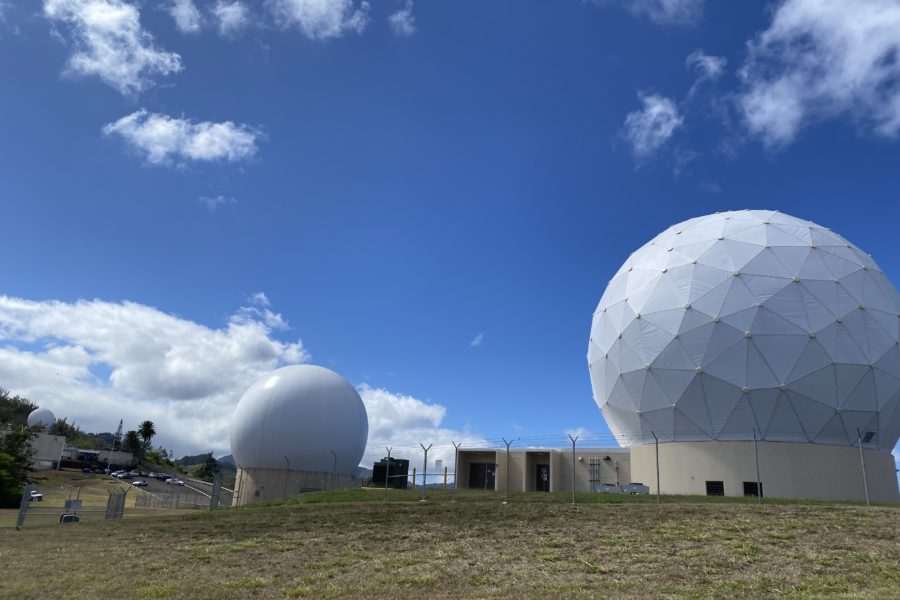KAENA POINT SPACE FORCE STATION, Oahu, Hawaii—Atop a ridge 1,500 feet above the waters of Yokohama Bay on Oahu island are six giant white globes concealing antennas for the collection of space data. The intelligence, surveillance, and reconnaissance data collected from satellites as they orbit over the Pacific is vital to the Space Force and Joint Force. But all too often, the aging antennas are down and deferring their tasks to other sites at island locations also operating with near-obsolete hardware at risk of failure.
The Space Force’s 21st Space Operations Squadron (SOPS), commanded by a single Guardian with the help of more than three dozen civilians and contractors, ensures the data flow in spite of the offline periods, switching from one antenna to another when possible. Together, the two Detachment 3 antennas under Space Force control form a pipeline to stream instructions to satellites and downlink data for the Defense Department, National Reconnaissance Office, other government agencies, and allies.
“Without us, space doesn’t happen,” Space Force Maj. Brandon Hammond, commander of the 21st SOPS Detachment 3 told Air Force Magazine. “Without the … operators identifying issues and fixing them, and making sure that the site is up and running, nobody would get to talk to the satellites.”
The slight elevation, up a single access road an hour north of Honolulu, is enough to give the 21st SOPS antennas visibility across thousands of miles of Pacific Ocean and capture data from satellites that pass between Satellite Control Network (SCN) sites at Naval Support Facility Diego Garcia in the Indian Ocean, on Guam, and at Vandenberg Space Force Station, Calif.
It is not uncommon for instructions from Schriever Space Force Base, Colo., to send coordinates for matching a satellite that are a few degrees off, or for the antennas to follow noise emanating from a different direction and lose a satellite’s vital data download. Contract operators under Hammond are closely monitoring dozens of tasks sent 24 hours a day to reposition antennas to maximize the data capture in passes that last as little as a few minutes.
“We provide on-demand command and control for 192 users around the world,” Hammond said.
The 21st SOPS’s two antennas are referred to as hula alpha and hula bravo. Hula alpha is a newer Remote Tracking Station Block Change (RBC) antenna with updated electronics, and hula bravo is considered a hybrid because it uses an older Automated Remote Tracking Station (ARTS) dish that dates to 1968 with upgraded electronics.
Dozens of times throughout the day, sirens buzz and red lights flash inside the building that houses hula bravo, alerting staff to stand clear as the 60-foot-wide dish rotates to the direction of the distant satellite as far away as geosynchronous orbit.
At a control station a few hundred yards away, one contractor is on each antenna station overseeing the instructions on four screens sent from Schriever or Space Operations Command at Peterson Space Force Base, Colo., crosschecking that the antennas are lining up to the satellite correctly and making adjustments. There is regular communication back to make sure objectives are met.
“We’re protecting and defending our assets, which underpins everything that we do day-to-day,” Hammond said.
But sometimes high-power amplifiers that transmit the instructions fail, requiring the operators to reset the system or shut it down entirely and replace components. When the station’s second antenna cannot pick up the task, it is re-rerouted to satellite control networks on the islands of Guam or Diego Garcia before the data download is missed.
Hammond, who took command in July 2021, will not see the upgrades to more reliable systems that are years away.
“Some of the electronics are old, dated, but it’s being upgraded slowly,” he said. “This is a years-long effort to get to the upgrade.”
The fiscal year 2023 defense budget calls for $51 million to move to an interim phase called the Modular Transitional Remote tracking station, and warns of significant increases in sustainment costs and decreases in operational capability if not fully funded. In the budget justification, ARTS is deemed obsolete and RBC is nearing end of life.
“Without it, the SCN will experience increased failure rates and lost contacts over time with the potential to impact or lose operational capability of on orbit payloads that rely on the SCN for command and control,” the FY23 Air Force budget reads. “The antiquated SCN system is already operating at the very edge of its capacity supporting over 170 satellites.”
Meanwhile, Guardians like Hammond are leveraging the creativity and know-how of contractors with decades of experience to squeeze additional life from the ARTS and RBC antennas before they can ultimately be replaced by phased array radars.
“With the increase of space traffic, the needs to be able to track more is getting greater and greater,” he said. “Phased array radars are electronically steered as opposed to mechanically steered like these are, and also it enables you to track more than one satellite at a time.”
Thousands of miles away from the U.S. mainland, where acquisitions decisions are made, Hammond feels the impact.
“Being out here, even though we’re separated from the warfront, I’m a user now, and the things that the program officers do directly affect my day-to-day life,” he said. “Test assets, operational assets, nobody talks to those without places like us. So, as we’re up there doing ISR on China or on whoever, we are the people that allow that to happen.”





